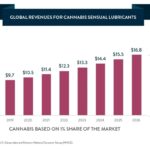For Valentine’s Weekend, Sensual Lubricants Add to Cannabis Options

Six Takeaways from the Colorado Cannabis Programs’ Past Three Years
February 9, 2020
Global Revenues For Cannabis Sensual Lubricants
February 16, 2020By Beau R Whitney, Vice President and Senior Economist, New Frontier Data
The combination of Valentine’s Day falling on a weekend tends to gladden marketers’ hearts, and that is especially true in the legal cannabis industry. Not only does February 14 traditionally mark the best single-day sales in the month, but weekly sales trends favor Fridays, as well. Put them together, and you find a natural sweet spot for retailers.
Given how cannabis enjoys well-storied, even legendary, associations as an aphrodisiac (long before Hollywood, mentions were found in each “One Thousand and One Nights”, Tantra practices, and Ayurveda medicine), it is understandable that the romantically inclined may opt for cannabis as more practical than flowers and less filling than chocolates.
Beyond the popular flower, concentrates, and edibles, of course, the mood of a romantic weekend also lends itself to a lesser known but increasingly significant market segment: sensual lubricants.
According to U.S. Census data and the Simmons National Consumer Survey (NHCS), nearly 50 million consumers in the U.S. have used personal lubricants, and as legalized cannabis becomes more commonplace producers will welcome their business. Global demand for sensual lubricants is projected to top $1.1 billion in 2020, growing to $1.6 billion by 2025. The U.S. portion of that is forecast to hit $350 million in 2020.
For now, cannabis-infused lubricants represent a small portion, anywhere between $3.5 million and $7.5 million. Yet Katie Stem, founder and CEO of Peak Extracts in Portland, Ore., expects that to change.
Her company specializes in the production of cannabis edibles, tinctures, vaporizers, and infused balms. Peak Extracts’ “Rescue Rub” is a top-selling balm in Oregon. With a background in laboratory science and experience as an herbalist, she has leveraged her background to develop new products, including a series of sensual lubricants.
“It is shocking how few lubes there are in the space,” she said, adding that “if I could, I would do this and nothing else. The opportunity is that large.”
While lubricants may seem to be a pretty straightforward product — just some slippery goo made from silicone, glycerin, or oil – they are actually classified and scrutinized by the FDA as a medical device, and therefore require months if not years to obtain regulatory approval. Manufacturers must comply with good manufacturing practices and receive advance 510(k) medical device clearance in order to sell their products. Lubricants are in a sub-class associated with prophylactics. The reason why sensual lubricants are so heavily regulated is that they go inside one’s body and must not inhibit the function of a prophylactic device (e.g., a condom).
Before being subjected to the approval process, of course, the product needs to undergo initial development. Invention can be very complex, including countless iterations and reformulations. To add complexity, researchers need to confirm considerations like how the human body reacts to the lubricant, and whether the product is shelf-stable as inventory.
“The key to cannabis lubes is osmolality and pH,” Stem explained. “If the body absorbs too much, then the lube dries up but the person gets a large dose of THC; on the other hand, if the osmolality is low, then the moisture remains, but no THC is absorbed into the body.” Other key issues include appropriate dosages, and how quickly the absorption takes place for the THC/CBD to take effect while the couple is engaged in sexual activity.
In the case of CBD products, most are designated as “massage oils” since the only CBD product with FDA approval is the patented drug Epidiolex (for pediatric epilepsy). Concerns about massage oils being used as lubricants include whether they might degrade the latex relied upon in condoms, or foster microbial or fungal growth and cause infections.
FDA approval can be obtained relatively quickly if the new product is non-differentiable from an already approved product, but new product types must undergo rigorous testing by the FDA. If a cannabis lubricant is primarily thought of as a sexual aide, there are many potential uses, including relief for vaginal dryness, menstrual cramps, or painful intercourse, and for some pre- or post-menopausal conditions including uterine prolapse.
Stem pointed out that as more baby boomers pass retirement age, they lend demand among an increasing clientele. “Boomers are getting old and dry; they need some help,” she teased. For the demographic that coined the phrase “Make love, not war,” so the beat goes on.




